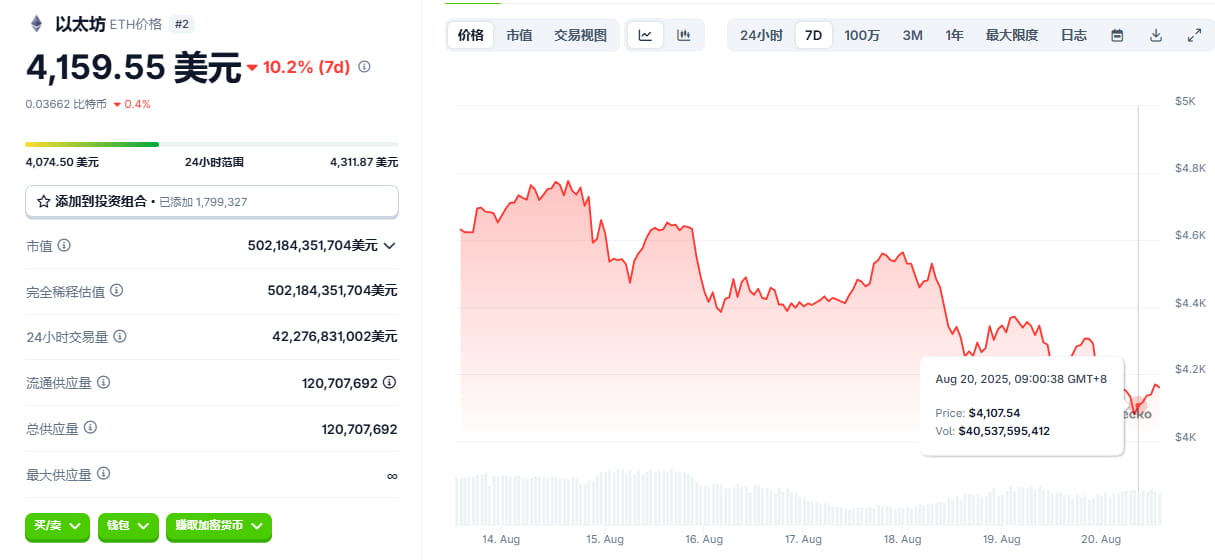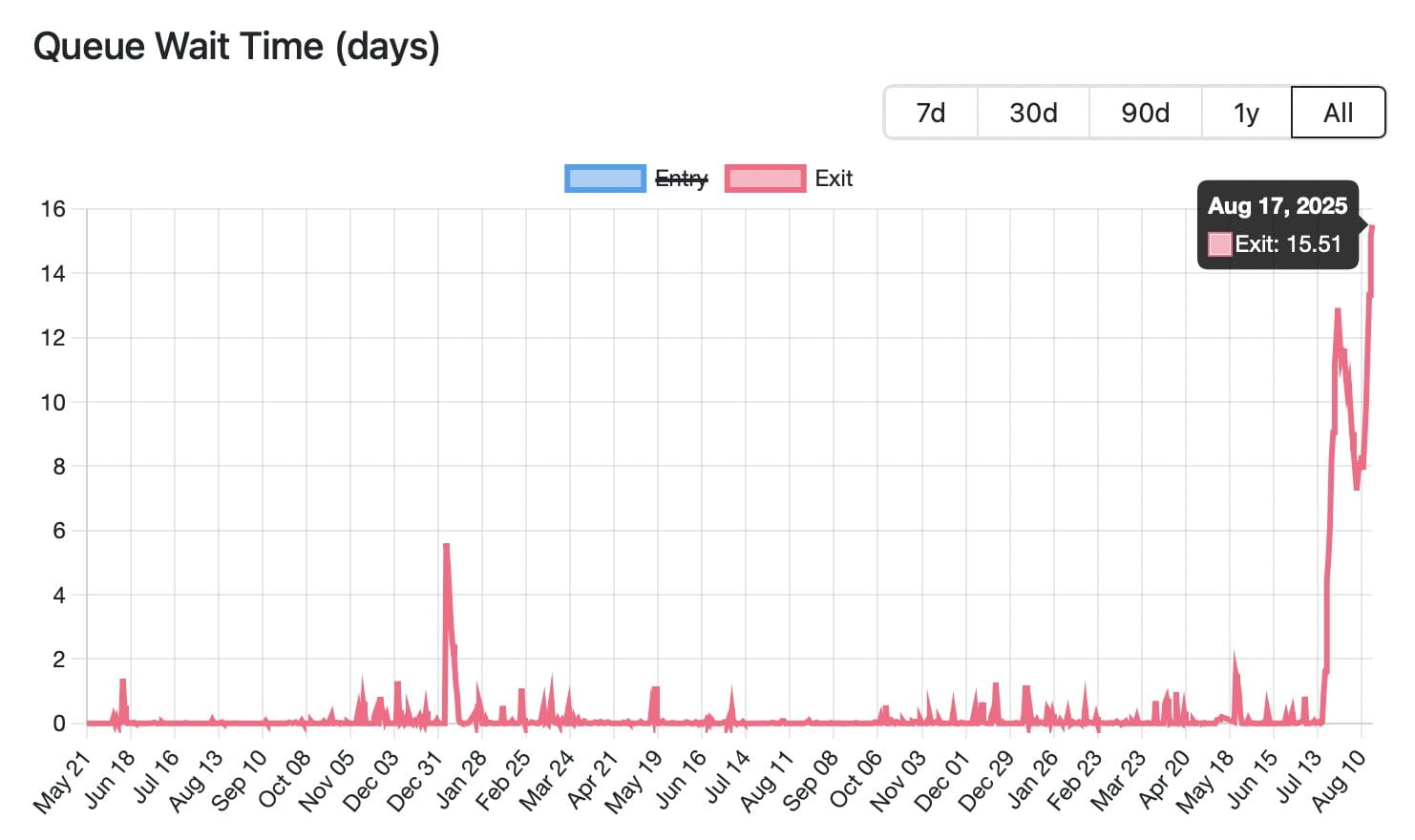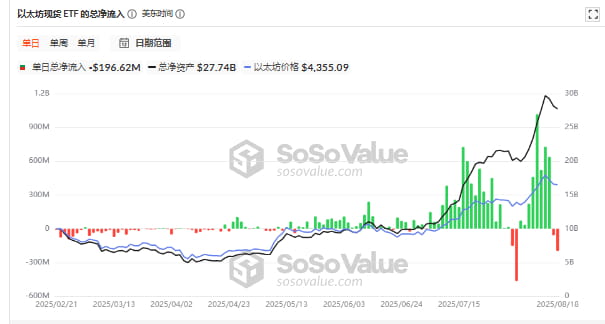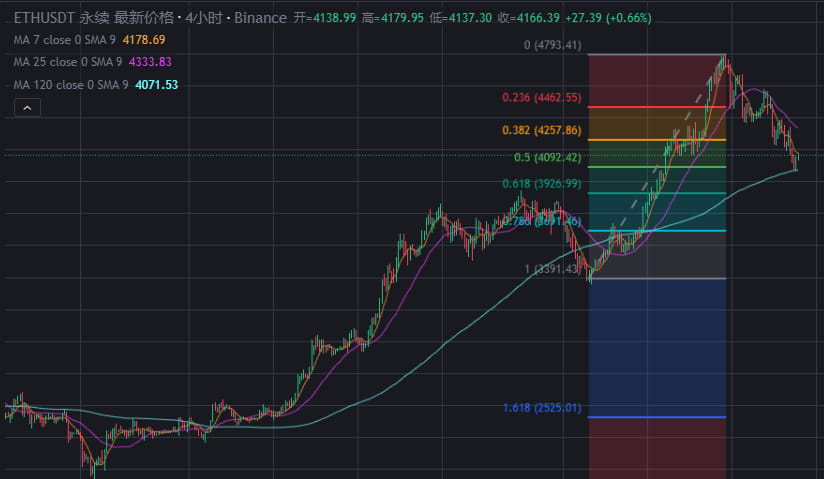
Ethereum's price suddenly cooled off under the scorching sun of August. According to CoinGecko, the second-largest cryptocurrency by market cap has plummeted 4.5% from a weekly high of $4,350, falling below the support level of $4,150, reaching a low of $4,060, marking the lowest point in nearly two weeks. This sell-off storm is not an isolated event—Bitcoin also fell back to the $113,000 mark, with the entire cryptocurrency market violently oscillating in the fog of Fed policies.
Staking logjam: $4 billion unlocking countdown.
Deep within the Ethereum proof-of-stake network, an unprecedented capital migration is brewing.

On-chain data shows that the current validator exit queue has reached as high as 910,461 ETH, which, at market price, corresponds to a massive $3.91 billion waiting to be released. More alarmingly, new staking demand is only 258,951 ETH (approximately $1.09 billion), resulting in a net potential selling pressure of 651,000 ETH, creating a funding gap of nearly $3 billion.
The cause of this capital surge hides profound changes in market structure:
Leverage strategy collapse: The Ethereum lending rate on the Aave platform surged to 6%, far exceeding the 4% staking yield, leading to the complete collapse of the circular staking strategy (borrow ETH → stake → borrow again). Investors were forced to unstake to repay loans, triggering a death spiral of "redemption → selling → price drop → more liquidations."
Institutional sentiment shift: Centralized staking platforms are rapidly encroaching on the market share of decentralized protocols. Institutions like Binance and Coinbase, which have KYC processes and node fault accountability mechanisms, attracted over 260,000 ETH in a single month, while Lido's market share fell to 24.4%. This migration reflects institutions' extreme pursuit of compliance and certainty.
Profit-taking surge: As the price of Ethereum approaches the historical high of $4,800 from 2021, early stakers are seeing a floating profit of over 223%. Xu Han, a partner at HashKey Capital, pointed out: "The record exit queue is primarily driven by profit-taking, as participants hope to lock in their gains."
Although Ethereum developer Preston Van Loon emphasized that the exit queue mechanism can prevent large-scale outflows of validators and maintain network security, it cannot change the reality that the potential selling pressure of $4 billion will eventually impact the market. The daily unlocking amount of about 24,000 ETH ($186 million) will continue to test the market's carrying capacity over the next 15 days.
The eye of the macro storm: A global chess game before Jackson Hole.
The turbulence in the cryptocurrency market coincides with a sensitive moment in global capital markets. The dramatic shift in expectations for Fed policy becomes a key variable: The U.S. July Producer Price Index (PPI) surged 3.3% year-on-year, far exceeding the expected 2.5%, instantly lowering the market's expectation for a Fed rate cut in September from 98% to 84%. U.S. Treasury yields rebounded sharply, and the appeal of risk assets diminished rapidly.
Three macroeconomic blades hanging simultaneously:
Policy expectation fog: The Jackson Hole global central bank annual meeting is imminent, and the upcoming keynote speech by Fed Chair Powell has become a market weather vane. Presto Research's head of research, Peter Chung, warned: "If Powell's remarks are not as dovish as expected, the market may experience a significant correction."
Fiscal policy shift: U.S. Treasury Secretary Yellen explicitly ruled out plans to allocate Bitcoin from Treasury yields, shattering market fantasies of "sovereign funds entering." Although hours later, she softened her stance on social media, stating she would explore "budget-neutral" paths to increase Bitcoin holdings, the uncertainty around policy has already fermented.
Geopolitical risks heating up: Wintermute trader Jake Ostrovskis revealed on social media that traders are preparing risk hedges in anticipation of Trump possibly delivering a "tough speech" at Jackson Hole. This "known unknown" intensifies capital risk-averse sentiment.

Market liquidity indicators have turned yellow. In the past 24 hours, $332 million in cryptocurrency contracts were liquidated across the network, affecting over 100,000 investors, with long positions accounting for as much as 71% of the liquidations. This leverage clearance is strikingly similar to the liquidity crisis in March 2020 (when Bitcoin fell 40% in two days) and the FTX collapse in 2022 (when Bitcoin plummeted 55%).
On-chain winter: Collapse of ecological activity and ETF bleeding.
The underlying vitality of the Ethereum network is fading at an alarming rate. Key on-chain indicators are all in the red:
Daily active addresses plummeted from 841,000 to 600,000, a drop of 28%.
The number of new addresses simultaneously shrank by 28%, from 192,000 to 138,000.
DeFi locked value sharply decreased by $3.7 billion in one week, revealing a vicious cycle of "shrinking demand → declining yields → exit from staking."

What is even more concerning is the shift in institutional capital flow. After experiencing a record single-week net inflow of $2.85 billion into Ethereum ETFs, a sudden net outflow of $196.6 million occurred on August 19, marking the second-largest capital flight since the product's launch. BlackRock's ETHA has cumulatively attracted $12.16 billion, but the outflow on Monday accounted for as much as 18%, indicating signs of short-term withdrawal from institutions.
This reversal of capital flow mirrors the Bitcoin ETF: Grayscale and Ark Invest's Bitcoin ETF experienced capital outflows, while BlackRock's IBIT still maintains net inflow. BTCMarkets analyst Rachael Lucas interpreted: "This is more about capital rotation rather than a collapse of confidence; investors are consolidating funds into lower-cost products."
Bitcoin linkage: Institutional chess game and market signals.

The trend of Bitcoin provides a key anchor for observing Ethereum. The largest cryptocurrency in the world has fallen 7.5% from its historical high of $124,350, showing a "stair-step" probing characteristic in its technical analysis.

This pullback resonates with MicroStrategy's (MSTR) stock price falling to a four-month low—the company announced it would relax stock issuance restrictions, allowing for "strategic stock issuance" when the stock price is below 2.5 times its net asset value.
Key signals in market fragmentation:
Derivatives warning: After reaching new highs, Bitcoin faced two obstacles, leading to a large number of leveraged long positions being automatically liquidated. CME Ethereum futures net positions show that hedge fund-driven Ethereum short positions surged from $2.3 billion on August 5 to $4.19 billion, nearly doubling.
Cycle positioning: HashKey Group's chief analyst Ding Zhaofei pointed out that this round of decline is more in line with a "normal pullback in an upward trend," dominated by deleveraging, distinguishing it from trend reversals driven by macroeconomic conditions and major industry events.
Altcoin retreat: The Coinmarketcap altcoin season index has dropped to 45, slightly up from 29 on August 11, but far from the "altcoin season" threshold. Data shows that only 45 of the top 100 cryptocurrencies by market cap have increased more than Bitcoin over the past 90 days, reflecting a systemic contraction in market risk appetite.
The market volatility surface reveals short-term anxiety: The 7-day implied volatility of Ethereum has risen to 73%, while the 30-day IV remains at 55%, indicating investors' tense expectations regarding the outcome of the Jackson Hole meeting.
Rebirth from the ashes: Value reconstruction after stress testing.

Despite short-term clouds looming, professional institutions remain cautiously optimistic about Ethereum's long-term carrying capacity. Arthur Azizov, founder of B2 Ventures, predicts that the price will consolidate between $3,900 and $4,400, waiting for clarity on "the Fed's policy shift and tech stock performance."
Xu Han from HashKey further emphasized the market's ability to absorb $4 billion in selling pressure: "Strong inflows from institutional ETFs and digital asset pools form a buffer."
I predict that Ethereum may test the 120-day moving average around $4,070 again in the short term, and it may even reach the Fibonacci 0.618 retracement at $3,926.
The balance of long and short battles hinges on two major turning points:
Technical upgrade progress: The EIP-4844 upgrade, expected to be implemented in October, will reduce Layer 2 transaction costs by 90%, potentially activating ecological vitality. If successfully implemented, ecological recovery may offset the disadvantages of staking yields.
Timing of policy shift: The current CME FedWatch tool shows an 82% probability of a rate cut in September. If Jackson Hole releases dovish signals, combined with cooling inflation data, risk assets may regain upward momentum.
Conclusion
As the last batch of leveraged longs fell in a blaze of $451 million in liquidations, the crypto market completed a brutal stress test. The unlocking of $4 billion in staking and the Jackson Hole meeting constitute a dual temporal fracture, while deep within the fracture, Ethereum is undergoing a painful transformation from speculative fuel to institutional asset.
Still the same saying, in a bull market, unsure what to do, click on Awen's avatar, follow, bull market spot planning, contract strategy, free sharing.
